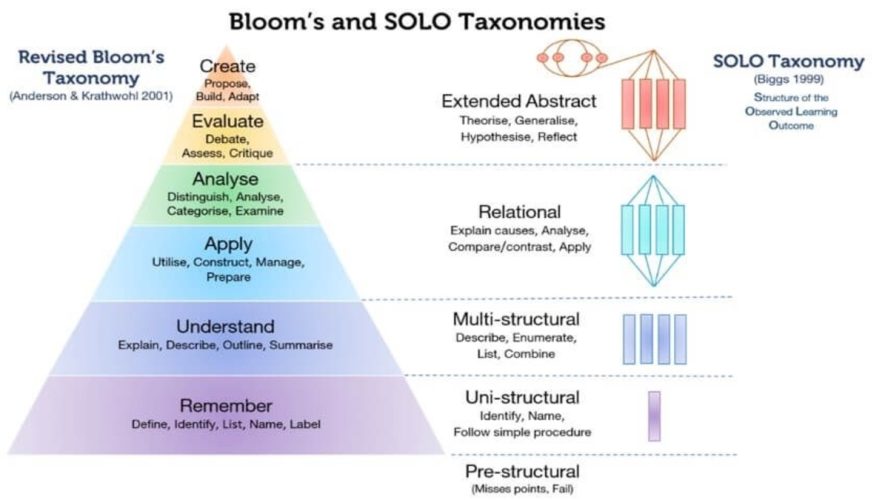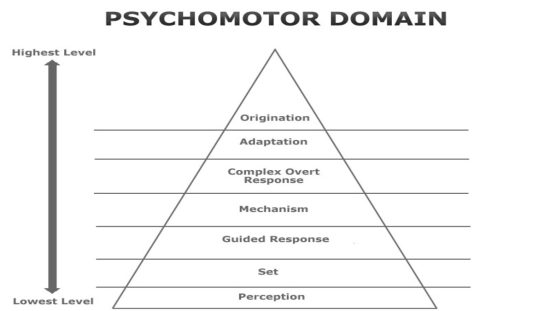The Bloom’s taxonomy (1956) has been extensively used in teacher education to suggest learning and teaching strategies, has formed the basis of many tests developed by teachers (at least while they were in teacher training), and has been used to evaluate many tests.
However, the SOLO (structure of observed learning outcome) taxonomy developed by Biggs and Collis (1982) is the most powerful model for understanding the three levels (surface, deep, conceptual) and integrating them into learning intentions and success criteria.
SOLO or Bloom’s — What to Prefer?
This is a common question that haunts most of our educators’ minds. Intentional use of learning taxonomies in classroom assessment is both relevant and worthwhile. Whether you prefer SOLO or Bloom’s doesn’t matter. What does make a difference is the deliberate and accurate alignment between the learning intentions and their assessment.
Here is the list of key differences that will help you to decide your preference.
- SOLO taxonomy is research/evidence based on structure of student learning outcomes while Bloom’s taxonomy was developed from proposal by a committee of educators.
- SOLO is a theory about teaching and learning while Bloom’s theory is about knowledge.
- SOLO is based on levels of ascending cognitive complexity while Bloom’s has questionable hierarchical link between levels. This is powerful when giving feedback, feed-forward and feed-up. Enables proximate – hierarchical – explicit feedback For example – Educators and students find it easy to determine what they are doing – the SOLO complexity of the task – Educators and students find it easy to reliably and validly determine how well it is going – SOLO differentiated success criteria – Educators and students find it easy to reliably and validly determine their next steps – plus one SOLO level.
- SOLO has high inter-rater reliability – educators and students tend to agree when moderating student work against SOLO levels – while Bloom’s has low inter-rater reliability.
- SOLO levels can be communicated through text, hand signs and symbols – across large and noisy learning environments while Bloom’s levels can be communicated by text alone.
- SOLO allows task and outcome to be at different levels while Bloom’s not designed/cannot be used to level outcomes against each task.
- SOLO enables us to distinguish between the cognitive complexity of a task and the difficulty of a task.
- SOLO has clarity of verb use for each level. Clarity of verb level is a powerful advantage when educators are planning and writing learning intentions whereas Bloom’s has confused verb use across levels.
- SOLO can be used to look at levels of declarative knowledge and functioning knowledge including metacognitive reflection.
- SOLO is brutally and blissfully simple and can be used by students as young as five to look at their own learning outcome and the learning outcomes of their peers
- SOLO is a model that shows students that learning is the result of effort and strategies NOT fixed ability or being liked. It shows learning progress and a plus 1 next step for every learner
Advantages of the SOLO taxonomy over the Bloom’s taxonomy for student learning
There are several advantages of the SOLO model over the Bloom’s taxonomy in the evaluation of student learning. These advantages concern not only item construction and scoring, but incorporate features of the process of evaluation that pay attention to how students learn, and how teachers devise instructional procedures to help students use progressively more complex cognitive processes.
- Unlike the Bloom taxonomy, which tends to be used more by teachers than by students, the SOLO can be taught to students such that they can learn to write progressively more difficult answers or prompts.
- In SOLO, There is a closer parallel to how teachers teach and how students learn.
- Both teachers and students often progress from more surface to deeper constructs and this is mirrored in the four levels of the SOLO taxonomy.
- There is no necessary progression in the manner of teaching or learning in the Bloom’s taxonomy.
- The SOLO levels can be interpreted relative to the proficiency of the students. Six year old students can be taught to derive general principles and suggest hypotheses, though obviously to a different level of abstraction and detail than their older peers. Using the SOLO method, it is relatively easy to construct items to assess such abstractions.
- The SOLO taxonomy not only suggests an item writing methodology, but the same taxonomy can be used to score the items. The marker assesses each response to establish either the number of ideas (one = unistructural; two = multi-structural), or the degree of interrelatedness (directly related or abstracted to more general principles). This can lead to more dependability of scoring.
- Unlike the experience of some with the Bloom taxonomy it is relatively easy to identify and categorize the SOLO levels.
- Moreover, teachers could be encouraged to use the ‘plus one’ principle when choosing appropriate learning material for students. That is, the teacher can aim to move the student one level higher in the taxonomy by appropriate choice of learning material and instructional sequencing.
OTHER RELATED POSTS



